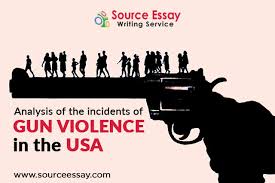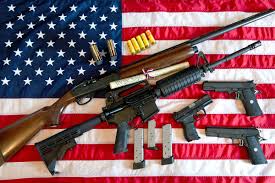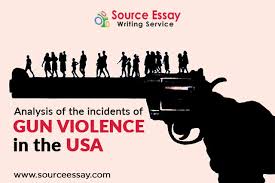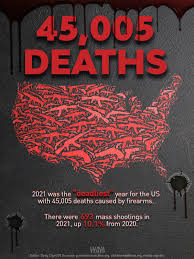Introduction

Gun violence is a pressing issue that continues to plague the United States, claiming thousands of lives each year and leaving countless others injured and traumatized. From mass shootings to everyday acts of gun violence, the impact reverberates through communities, schools, workplaces, and homes across the nation. This essay delves into the multifaceted nature of gun violence in the USA, examining its root causes, far-reaching impacts, and potential solutions.
The Landscape of Gun Violence
Gun violence in the USA encompasses a wide range of incidents, including homicides, suicides, unintentional shootings, and mass shootings. The accessibility and prevalence of firearms contribute to the scale and severity of the problem. With an estimated 393 million civilian-owned firearms, the USA has one of the highest rates of gun ownership per capita globally. This abundance of firearms, combined with lax gun laws and regulatory loopholes, creates a fertile environment for gun violence to proliferate.
Root Causes of Gun Violence
The root causes of gun violence are complex and multifaceted, influenced by individual, societal, and structural factors. At the individual level, factors such as mental illness, substance abuse, and impulsive behavior can contribute to acts of gun violence. Additionally, interpersonal conflicts, including domestic disputes and gang-related violence, are common precursors to gun violence in communities.
Societal factors
including poverty, unemployment, and social inequality, also play significant roles in driving gun violence. Disadvantaged neighborhoods with limited economic opportunities and access to resources are disproportionately affected by gun violence. Furthermore, systemic issues such as racism, discrimination, and trauma contribute to the perpetuation of cycles of violence within marginalized communities.
Impacts of Gun Violence
The impacts of gun violence extend far beyond the immediate victims and perpetrators, affecting families, communities, and society as a whole. Each year, tens of thousands of lives are lost to gun violence, leaving families devastated and communities in mourning. Survivors of gun violence often face long-term physical and psychological consequences, including chronic pain, disabilities, PTSD, and survivor’s guilt.
The economic costs
of gun violence are staggering, encompassing medical expenses, lost productivity, and criminal justice expenditures. Moreover, the fear and trauma associated with gun violence can have ripple effects throughout communities, impacting mental health, social cohesion, and overall well-being. Children exposed to gun violence may experience academic setbacks, behavioral problems, and long-term psychological harm, perpetuating cycles of trauma and violence across generations.
Solutions to Gun Violence

Addressing gun violence requires a comprehensive and multi-pronged approach that encompasses both prevention and intervention strategies. Legislative measures to strengthen gun laws and close regulatory loopholes are essential to reduce access to firearms among high-risk individuals, including domestic abusers, individuals with a history of violence, and those with severe mental illness.
Universal background check
Red flag laws, and safe storage requirements are among the policy interventions that have demonstrated efficacy in reducing gun violence. Additionally, investment in community-based violence prevention programs, such as youth mentoring initiatives, conflict mediation, and trauma-informed care, can help address the root causes of violence and interrupt the cycle of retribution.
Public health approaches

To gun violence focus on data-driven research, surveillance, and evidence-based interventions to prevent and mitigate the impact of gun violence. Research funding and data collection efforts are essential to understanding the epidemiology of gun violence and identifying effective strategies for prevention and intervention. Furthermore, collaboration between law enforcement, healthcare providers, community organizations, and policymakers is critical to implementing coordinated responses to gun violence at the local, state, and national levels.
Types of Gun Violence:
Gun violence in the USA encompasses various types of incidents, including:a. Homicides: The use of firearms to intentionally cause the death of another person. Homicides can occur in the context of criminal activity, interpersonal conflicts, domestic disputes, or acts of terrorism.
Suicides:
Firearms are the most common method of suicide in the USA. Access to firearms increases the lethality of suicide attempts, leading to higher success rates compared to other methods.
Unintentional Shootings:
Accidental shootings resulting from mishandling, improper storage, or negligent discharge of firearms. Children are particularly vulnerable to unintentional shootings, often accessing firearms left unsecured in homes.
Gang-Related Violence:
Gun violence associated with criminal gangs and illicit drug trade. Gang conflicts over territory, disputes, and retaliatory acts contribute to high rates of gun violence in certain urban areas.c
ss Shootings:
Defined as incidents where four or more individuals are shot and killed in a single event, excluding the perpetrator. Mass shootings often receive significant media attention and can occur in various settings, including schools, workplaces, places of worship, and public spaces.
Demographics and Trends:
Certain demographic groups are disproportionately affected by gun violence in the USA. Black Americans, particularly young Black men, experience significantly higher rates of gun homicide compared to other racial and ethnic groups. Additionally, individuals living in urban areas, impoverished neighborhoods, and communities with high rates of unemployment and social inequality are at increased risk of exposure to gun violence.
Access to Firearms:
The USA has relatively lax gun laws compared to other developed countries, resulting in widespread availability and accessibility of firearms. Federal law requires background checks for gun purchases from licensed dealers but does not mandate checks for private sales, including those conducted at gun shows and online. The presence of loopholes in existing gun laws, such as the “gun show loophole” and “Charleston loophole,” allows individuals to bypass background checks and acquire firearms without proper screening.
Impact on Public Health:
Gun violence is recognized as a significant public health issue in the USA, with far-reaching consequences for individuals, families, and communities. Each year, tens of thousands of lives are lost to gun violence, and hundreds of thousands more are injured. Survivors of gun violence often face long-term physical and psychological consequences, including disabilities, chronic pain, PTSD, and depression. Additionally, the fear of gun violence can have detrimental effects on mental health, contributing to anxiety, stress, and trauma within affected communities.
Intersectionality and Marginalization:
Gun violence intersects with various forms of systemic oppression, including racism, poverty, and social marginalization. Black and brown communities disproportionately bear the burden of gun violence, facing higher rates of homicide, mass incarceration, and police violence. Additionally, LGBTQ+ individuals, women, immigrants, and individuals with disabilities may face heightened vulnerabilities to gun violence due to intersecting forms of discrimination and marginalization.

Role of Firearms Industry and Lobbying:
The firearms industry, including manufacturers, retailers, and advocacy groups such as the National Rifle Association (NRA), wields significant influence over gun policy in the USA. The NRA and other pro-gun organizations lobby against gun control measures and advocate for expansive interpretations of the Second Amendment right to bear arms. Additionally, the firearms industry profits from the sale of firearms and ammunition, contributing to the perpetuation of gun culture and the normalization of gun ownership in American society.
Policy Responses:
Efforts to address gun violence in the USA are often met with political polarization and resistance from pro-gun advocates. Despite widespread public support for measures such as universal background checks and assault weapons bans, progress on federal gun control legislation has been slow and incremental. State and local governments have implemented their own gun control measures, including red flag laws, assault weapons bans, and restrictions on high-capacity magazines. However, the patchwork of state laws and regulatory disparities underscores the need for comprehensive federal action to address gun violence on a national scale.
Community-Based Interventions:
In addition to legislative and policy measures, community-based organizations and grassroots initiatives play a crucial role in addressing gun violence at the local level. Violence intervention programs, such as Cure Violence and Ceasefire, employ a public health approach to prevent and interrupt cycles of violence within communities. These programs engage community members, outreach workers, and trusted messengers to mediate conflicts, provide support to at-risk individuals, and connect them with resources and opportunities to break free from cycles of violence.
By understanding the complexities of gun violence and implementing evidence-based strategies that address its root causes, the USA can work towards reducing the devastating toll of gun violence and creating safer and more resilient communities for all individuals. Collaboration among policymakers, community leaders, advocates, and affected communities is essential to effectively address gun violence and promote meaningful change.
Conclusion

Gun violence remains a pervasive and urgent public health crisis in the United States, demanding immediate action and sustained commitment from policymakers, stakeholders, and communities. By addressing the root causes of gun violence, strengthening gun laws, and investing in prevention and intervention efforts, the USA can work towards creating safer and more resilient communities for all individuals. Through collective action and collaboration, we can build a future where the devastating toll of gun violence is no longer a defining feature of American society.




